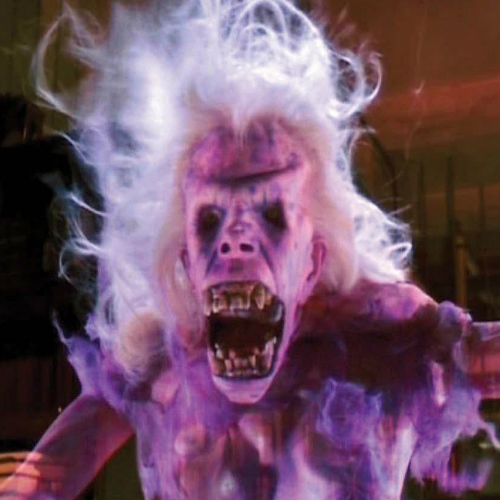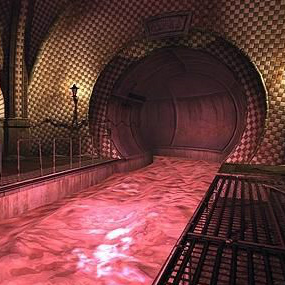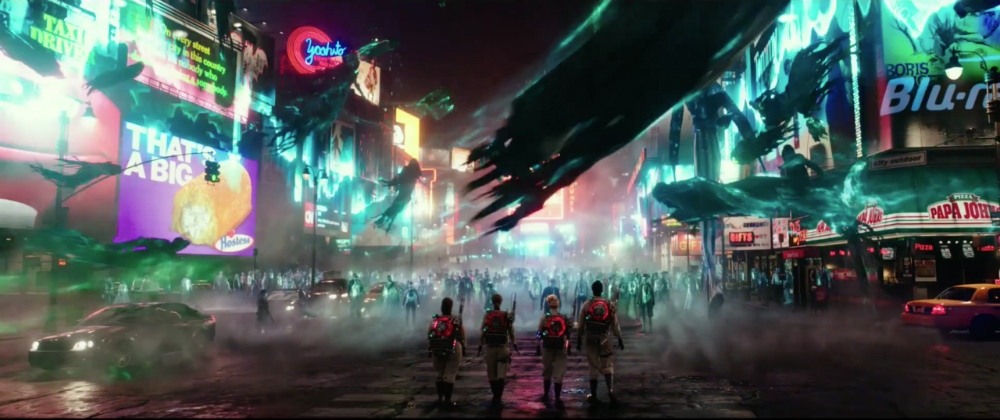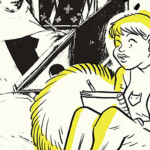
Ghostbusters II (1989) came out the year I was born. So, lucky for me, and all you 1989+ crowd, we were able to experience Ghostbusters (1984) and Ghostbusters II at the same time. We didn’t have to wait five years to see Slimer’s goofy green face again. And here we are, as Ghostbusters is made anew nearly two decades later, returning to the films that managed to mix horror and humour through a colourful (and memorable) cast of ghoulish beings.
The Use of “GHOST”

Our first order of business is to establish “ghost” in the Ghostbusters as a catch-all term for all supernatural phenomenon. In folklore and mythology, the term “ghost” is generally applied to the spirit of a dead person that is trapped between this world and the next. Usually a ghost can be found haunting a particular location because 1) a tragic event occurred there related to that person and/or because 2) the person needs to gain closure before they are able to transition to the afterlife. Ghosts are often described as translucent and/or glowing, sometimes fully dressed and in human form—although not corporeal. The shining, blueish human figure is usually what we see in Hollywood ghosts, but it is quite different from what ghost experts will tell you. I went on a ghost tour in Harpers Ferry, West Virginia, one October a few years ago, and the guide told us to use our phones to take pictures. If any glowing orbs (balls of light) appeared in our pictures, he claimed that that was a ghost. If we were lucky(?), he suggested that we might even see some white swirls, vapour, or evidence of ectoplasm.
All that being said, the ghosts in Ghostbusters are very diverse. Here, we see quite a range of supernatural activity from demonic possession to zombies to demigods—all alongside your more traditional ghosts. At first thought, it might seem that calling everything a “ghost” is the easy way out—not so much. You might recall the CDI System, first referred to by Ray in Ghostbusters after the Sedgewick Hotel incident. The system involves three steps: classify, describe, identify.
Although the details of the CDI System aren’t revealed in the films, thanks to a fantastic fan base a wonderful diagram (pictured below) was created for Ghostbusters: A Frightfully Cheerful Roleplaying Game (1986) and Ghostbusters: International (1989):

As illustrated, there are seven classes of supernatural beings. The higher the class, the more dangerous and developed the ghost.
Alright, recap! We have established that “ghost” encompasses a whole lot in Ghostbusters, and for the sake of Ghostbusters’ ghost lore, using the term “ghost” to refer to a zombie is not incorrect. Just take that additional step and classify it—you know, if you want to, if you’re committed. Now onto the ghosts!
MAJOR GHOSTS FROM THE FILMS
Top Five: Ghostbusters (1984)
SLIMER
 Let’s start with Slimer: the only ghost to appear in both Ghostbusters and Ghostbusters II — as well as a variety of cartoons, video games, comics and such. He is also quite possibly the most popular of the Ghostbuster ghosts. He was the first ghost captured by the Ghostbusters, and I remember his crazy grin and bright green glow seemed quite friendly and inviting to my childhood self.
Let’s start with Slimer: the only ghost to appear in both Ghostbusters and Ghostbusters II — as well as a variety of cartoons, video games, comics and such. He is also quite possibly the most popular of the Ghostbuster ghosts. He was the first ghost captured by the Ghostbusters, and I remember his crazy grin and bright green glow seemed quite friendly and inviting to my childhood self.
Based on the chart above, Slimer is a Class V ghost. He is a vaporous manifestation that does not have a human shape. As indicated on the chart, these types of ghosts are believed to be caused by particular events such as occult rituals (as in the case of Slimer) or other traumatic situations.
It is rumoured that Slimer was deemed “Slimer” by viewers (as he is never actually mentioned by name in the first film). He was referred to as Onionhead on set. And, he was also supposedly called the “Ghost of John Belushi”—after the actor, who was one of the original brains behind Ghostbusters, unexpectedly died in 1982 from a drug overdose.
DREAM GHOST
 The first time I saw the Ghostbusters films, I was really young—too young to understand what was going on in certain scenes. This would be one of them: the infamous sexual encounter between Ray Stantz (Dan Akroyd) and a female ghost (Kym Herrin).
The first time I saw the Ghostbusters films, I was really young—too young to understand what was going on in certain scenes. This would be one of them: the infamous sexual encounter between Ray Stantz (Dan Akroyd) and a female ghost (Kym Herrin).
The Dream Ghost scene received negative attention by viewers as the whole event is deemed unnecessary and awkward. Who is the ghost? Why create a love interest for Ray? Supposedly, there was a deleted scene that gave us more of the ghost’s background. Yet, even without the (seemingly necessary) background, Harold Ramis thought the scene was important because ghosts having sex with humans is a thing…news to me!
The Dream Ghost falls between two classes: Class III and Class IV. A Class III ghost is anonymous. Even though it may have a clear human form (as we do with the Dream Ghost), the identity of the ghost remains unknown. However, as mentioned above, the deleted scene would have provided viewers with the identity of the ghost , and, when that is able to occur, a Class III ghost becomes a Class IV ghost.
LIBRARY GHOST (THE GREY LADY)
 I love books. I love libraries. I love ghosts. I do not love ghosts in my libraries—particularly ones that look like the library ghost in Ghostbusters. This ghost, perhaps more than any other ghost in the first film, rattled me the most as a child.
I love books. I love libraries. I love ghosts. I do not love ghosts in my libraries—particularly ones that look like the library ghost in Ghostbusters. This ghost, perhaps more than any other ghost in the first film, rattled me the most as a child.
The ghost in the film functions mainly to frighten viewers; however, she does have a much more prominent role in Ghostbusters: The Video Game (2009). Here, the ghost is identified: Dr. Eleanor Twitty, a former librarian at the New York Public Library. Supposedly, Twitty was seduced by a man who simply wanted to use her for access to rare books. When she found out what his plans were, he murdered her inside the library. In the video game, your task is to help her move on.
Like with the Dream Ghost, the Library Ghost wavers between a Class III and a Class IV ghost. We don’t actually find out who she is in the film. So, it all depends on whether you are strictly going by what information the films provide (which would leave them both at Class III), or if you take into account deleted scenes and video games (moving them to a Class IV).
VINZ CLORTHO THE KEYMASTER and ZUUL THE GATEKEEPER
 Vinz Clortho is the Keymaster of Gozer and Zuul is the Gatekeeper of Gozer.
Vinz Clortho is the Keymaster of Gozer and Zuul is the Gatekeeper of Gozer.
While they both look like demonic hellhounds in their “natural” form, they possess human bodies: Vinz Clortho takes the form of a male (Louis Tully), while Zuul inhabits a female body (Dana Barrett).
While Vinz Clortho and Zuul are quite menacing in the films, they do add a bit of humor. In the early drafts, Vinz Clortho was intended to be even more clumsy than he already is, and there was going to be a scene with Zuul comforting a bridled horse—showing sympathy for its captive state.
These are Class VII ghosts. The most malevolent and powerful of the classes, Class VII ghosts include demi-gods, gods, and demons.
GOZER THE DESTRUCTOR
 Among a whole cast of malevolent ghosts, Gozer is the infamous villain of the first film. As the story goes, Gozer was a powerful deity worshipped in 6000 BCE by the Hittites and the Sumerians, along with Gozer’s minions Zuul and Vinz Clortho—who were revered as demi-gods. Therefore, along with Zuul and Vinz Clortho, Gozer is a Class VII ghost.
Among a whole cast of malevolent ghosts, Gozer is the infamous villain of the first film. As the story goes, Gozer was a powerful deity worshipped in 6000 BCE by the Hittites and the Sumerians, along with Gozer’s minions Zuul and Vinz Clortho—who were revered as demi-gods. Therefore, along with Zuul and Vinz Clortho, Gozer is a Class VII ghost.
Gozer took two forms in the film—two VERY different forms.
First, we have the androgynous glam rocker of Gozer’s original appearance.
Second, we have the Stay Puft Marshmallow Man.
Thin genderless rocker to puffy cartoon marshmallow—this is why we love Ghostbusters and Ray, of course, for thinking of something so harmless yet menacing.
 Gozer’s two forms had some fantastic inspiration. Inspiration for Gozer’s glam rocker appearance comes from the looks of David Byrne of Talking Heads, David Bowie, Grace Jones, and Anna Carlisle. The Stay Puft Marshmallow Man’s troupe of inspiration is equally impressive: Pillsbury Doughboy, Angelus Puft Marshmallow Man, and the Michelin Man.
Gozer’s two forms had some fantastic inspiration. Inspiration for Gozer’s glam rocker appearance comes from the looks of David Byrne of Talking Heads, David Bowie, Grace Jones, and Anna Carlisle. The Stay Puft Marshmallow Man’s troupe of inspiration is equally impressive: Pillsbury Doughboy, Angelus Puft Marshmallow Man, and the Michelin Man.
This is the ghost that defines Ghostbusters both as a movie and a franchise. The word iconic isn’t strong enough for what the Stay Puft Marshmallow Man means to Ghostbusters.
Top Five: Ghostbusters II (1989)
PSYCHOMAGNOTHERIC SLIME (MOOD SLIME)
 If there is a ghost you want in your back pocket (metaphorically of course), this would be it. The substance responds to human emotions, has the ability to animate into various objects, and can be a portal for ghosts to enter our world. If you aren’t convinced yet…it can make a toaster dance. Not bad, eh?
If there is a ghost you want in your back pocket (metaphorically of course), this would be it. The substance responds to human emotions, has the ability to animate into various objects, and can be a portal for ghosts to enter our world. If you aren’t convinced yet…it can make a toaster dance. Not bad, eh?
Would it surprise anyone to hear that this slime is brewing under New York City? Supposedly, Harold Ramis thought that all New York chaos and briskness and general East Coast negativity (I can say that as a former East Coaster) could be enough to fuel some serious supernatural activity.
The slime is a Class V ghost. Although it has a much less distinct form than Slimer, its malleability just increases its emotionally-charged power.
THE SCOLERI BROTHERS
 As the story goes, Tony Sloceri (the thin one) and his brother Nunzio Scoleri (the heavy one) were two murderers, tried and executed by Stephen Wexler in the 1940s. While the Ghostbusters are in court with Wexler over 40 years later, the ghosts of the Solceri brothers manifest—thanks to all the negative energy generated by the slime.
As the story goes, Tony Sloceri (the thin one) and his brother Nunzio Scoleri (the heavy one) were two murderers, tried and executed by Stephen Wexler in the 1940s. While the Ghostbusters are in court with Wexler over 40 years later, the ghosts of the Solceri brothers manifest—thanks to all the negative energy generated by the slime.
The Solceri brothers are, you guessed it, Class IV ghosts: distinguishable human form and identity is known. Interestingly enough, the Scoleri brothers in the film are based on real Scoleri brothers—though no one quite knows which Scoleri brothers! There was a pair of Scoleri brothers who robbed a store owned by Harold Ramis’s father (quite possibly the inspiration), but there was also a different set of Scoleri brothers who robbed and murdered a store owner in Philadelphia.
JANOSZ POHA
 The story of Janosz Poha is familiar: a guy who has a hopeless crush on Dana gets controlled by a demonic force. It is Louis Tully and Gozer all over again, in the form of Janosz and Vigo now. What is perhaps most interesting to me about Janosz however is that his personality remains pretty consistent both before and after possession—perhaps hinting at the madness of art enthusiasts/artists (I say this as one), or simply the lonely lovesick?
The story of Janosz Poha is familiar: a guy who has a hopeless crush on Dana gets controlled by a demonic force. It is Louis Tully and Gozer all over again, in the form of Janosz and Vigo now. What is perhaps most interesting to me about Janosz however is that his personality remains pretty consistent both before and after possession—perhaps hinting at the madness of art enthusiasts/artists (I say this as one), or simply the lonely lovesick?
Fun fact! Early in the film drafts, Janosz Poha was not scripted to kidnap Oscar, Dana’s baby. Other creatures pitched: a large pigeon, a dragon with not one but two heads, a Moon with a face, and, perhaps my favorite, an evil Santa Claus.
Janosz Poha, as well the last two ghosts mentioned here (Possessed Ray and Vigo) are all Class VII ghosts. Janosz Poha and Ray become possessed by a Class VII ghost (remember, malevolent and extremely dangerous) and Vigo is one, so they are all in the same camp–not one I’d like to visit.
POSSESSED RAY
 Beyond being a resident Ghostbuster, Ray had numerous jobs in Ghostbusters II: party entertainer, owner of Ray’s Occult Books, and host to Vigo. Why Ray? How did a senior Ghostbuster become possessed? Well, Ray is undoubtedly the most open-minded and enthusiastic of the group. Although he does seem skeptical about the existence of God, he demonstrates a fairly thorough understanding of the religion and folklore. And his bookstore, of course, only emphasizes his interest in the occult.
Beyond being a resident Ghostbuster, Ray had numerous jobs in Ghostbusters II: party entertainer, owner of Ray’s Occult Books, and host to Vigo. Why Ray? How did a senior Ghostbuster become possessed? Well, Ray is undoubtedly the most open-minded and enthusiastic of the group. Although he does seem skeptical about the existence of God, he demonstrates a fairly thorough understanding of the religion and folklore. And his bookstore, of course, only emphasizes his interest in the occult.
Dan Aykroyd is actually quite similar to his character Ray in his openness and interest in the spirit world. Aykroyd grew up in a household where paranormal activity was an everyday occurrence, and he even penned a book titled A History of Ghosts: The True Story of Séances, Mediums, Ghosts, and Ghostbusters (2009).
VIGO THE CARPATHIAN
 The main villain in Ghostbusters II is Vigo: a medieval Hungarian dictator who was brutally murdered by his people in the early 1600s. Feeding off of the energy created by the slime, Vigo reenters the world through a self-portrait located in the Manhattan Musuem of Art, where Dana and Janosz Poha both work.
The main villain in Ghostbusters II is Vigo: a medieval Hungarian dictator who was brutally murdered by his people in the early 1600s. Feeding off of the energy created by the slime, Vigo reenters the world through a self-portrait located in the Manhattan Musuem of Art, where Dana and Janosz Poha both work.
Vigo went through many changes in the draft stage—an abbot, to a Russian immigrant, to a bishop. But perhaps my favorite early draft sketch was Vigo as Jason Locke, a 30-something year old musician making his way in New York, who meets Lane Walker at none other than a Black Sabbath concert.
GHOSTBUSTERS 2016

After revisiting some of the iconic ghosts from the world of Ghostbusters lore, I’m excited to see what 2016 Ghostbusters will bring! It’s rumoured that the ghosts in the newest film are all brand new and more human-like. While this may seem disappointing to those loyal to the 80s Ghostbusters’ ghosts, it might be wise to start fresh. For, as Colin Fredericson rightly poses, “…who or what could ever hope to compete with the likes of Slimer and Stay Puft Marshmallow Man anyway?”



![[REVIEW] MURDERWORLD: AVENGERS #1](https://geekd-out.com/wp-content/uploads/2022/11/murderworld-avengers-1-feat-150x150.jpeg)